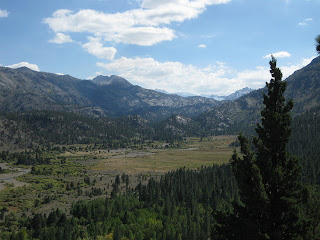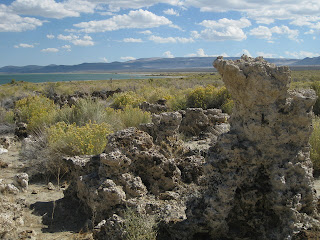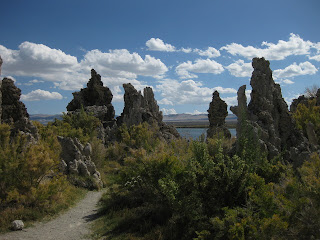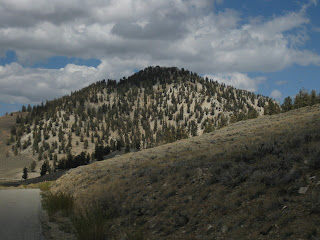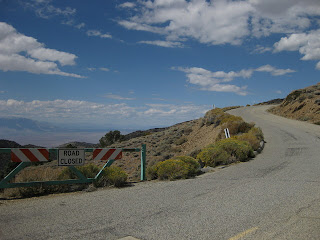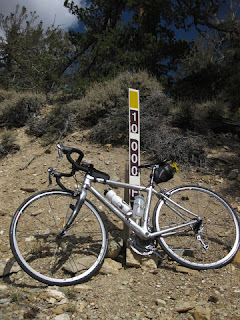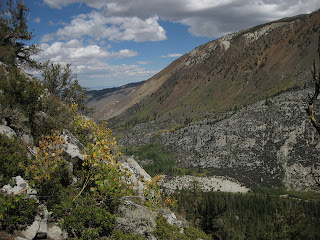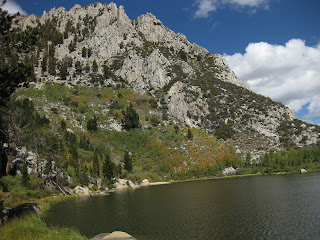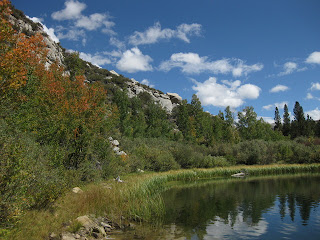Our ride leader presented us with a choice for today's loop: clockwise for an easier climb, counter-clockwise for lunch at Arcangeli's.
[No contest.]
This is a popular cycling route; you're never alone at the San Gregorio General Store. My photo has it all: eclectic merchandise, live music (inside), cyclists (outside), and the marine layer over rolling hills.
Arcangeli's, aka Norm's Market, is the source of some heavenly carbs. Artichoke Garlic Herb bread. Hot-out-of-the-oven Artichoke Garlic Herb bread. It wasn't hard to devour the three loaves we bought. One rider pressed a plastic grocery bag into service as a backpack to tote a loaf home. [Uphill.] That's how good this bread is. Unless you've had it, you've had nothing like it.
This little piggie didn't go to market. Mom was nearby, but we suspected that both of them were on the lam in the field where we spotted them.
The skies were clear by the time we started up Haskins Hill; somehow, that's always the way it is. The marine layer lifted late enough to keep us from overheating on the exposed part of the climb. One rider, less prepared, dismounted and walked up the last stretch.
For the day, 31 miles and a modest 2,280 feet of climbing. Not enough, I'm afraid, to offset my intake of heavenly bread. And that's okay by me.
September 20, 2014
September 17, 2014
Sonora Pass
I was so inspired by the Sonora Pass on my way to the Eastern Sierras that I chose to return to the Bay Area over the same route. Following no timetable, I could dawdle along the way.
A steep hairpin rounded an overlook where I found a forestry worker monitoring a distant fire near Yosemite. Bypassing the famous National Park had kept me clear of the crowds, and the smoke.
The next stop that caught my eye was Leavitt Falls. Given the current state of drought, my expectations were low. Happily, some water was flowing.
The summit beckoned, but ... what about that cooler on the front seat of my car? Signs in the parking area recommended the bear-proof lockers, explaining that the bears know what a cooler signifies. I was car hiking, not car camping; should I worry?
As I picked my way along the crumbly trail up the hill, I wondered why I hadn't taken a few moments to don my hiking boots and grab my walking stick. Climbing back down would be tricky.
At this pace, I reckoned it might take most of the day to complete the 80-mile scenic drive. And that was fine with me.
My last stop was the Donnell Vista. I'm not uncomfortable with heights, but here I met my match. Gazing up at the distant lava formations of the Dardenelles was much easier than gazing down [way, way down] at Donnell Lake and the Middle Fork of the Stanislaus River. I must have never stood at the edge of such a precipice, till now.
Past this point, the road snaked through the forest and delivered me to the edge of the Central Valley by dusk, bringing my fall Sierra adventure to a close.
A steep hairpin rounded an overlook where I found a forestry worker monitoring a distant fire near Yosemite. Bypassing the famous National Park had kept me clear of the crowds, and the smoke.
The next stop that caught my eye was Leavitt Falls. Given the current state of drought, my expectations were low. Happily, some water was flowing.
The summit beckoned, but ... what about that cooler on the front seat of my car? Signs in the parking area recommended the bear-proof lockers, explaining that the bears know what a cooler signifies. I was car hiking, not car camping; should I worry?
As I picked my way along the crumbly trail up the hill, I wondered why I hadn't taken a few moments to don my hiking boots and grab my walking stick. Climbing back down would be tricky.
At this pace, I reckoned it might take most of the day to complete the 80-mile scenic drive. And that was fine with me.
My last stop was the Donnell Vista. I'm not uncomfortable with heights, but here I met my match. Gazing up at the distant lava formations of the Dardenelles was much easier than gazing down [way, way down] at Donnell Lake and the Middle Fork of the Stanislaus River. I must have never stood at the edge of such a precipice, till now.
Past this point, the road snaked through the forest and delivered me to the edge of the Central Valley by dusk, bringing my fall Sierra adventure to a close.
Mono Lake
I have wanted to visit Mono Lake from the first time I saw a photo of its iconic spires, well before I moved to the west coast. From the Bay Area, it's a long drive ... and I'm not particularly comfortable with long drives.
I made it out there, finally, to cycle in the Eastern Sierras. As I drove past the lake, I couldn't resist making a quick stop. Surely I could manage a proper visit today, early on my long drive home.
Rather than the visitor center on the western shore, close to the highway, I headed for the southern edge to get a good look at the famed tufa formations.
I wandered freely on the trails. There was a small group of children on a school trip, but otherwise not much of a crowd. Curious, I dipped my fingers in the alkaline water. Not surprisingly, it felt soapy.
The passing clouds and the wind altered the view throughout my visit; it would be easy to spend the better part of a day here, especially when the migrating birds are in town. But having stretched my legs and my sense of wonderment, it was time to embark on the next phase of my journey. Westward, home!
I made it out there, finally, to cycle in the Eastern Sierras. As I drove past the lake, I couldn't resist making a quick stop. Surely I could manage a proper visit today, early on my long drive home.
Rather than the visitor center on the western shore, close to the highway, I headed for the southern edge to get a good look at the famed tufa formations.
I wandered freely on the trails. There was a small group of children on a school trip, but otherwise not much of a crowd. Curious, I dipped my fingers in the alkaline water. Not surprisingly, it felt soapy.
The passing clouds and the wind altered the view throughout my visit; it would be easy to spend the better part of a day here, especially when the migrating birds are in town. But having stretched my legs and my sense of wonderment, it was time to embark on the next phase of my journey. Westward, home!
September 16, 2014
Death Valley Road
With a name like Death Valley Road, you might expect today's ride would be exceptionally grueling. This would be my final ride with the group, and after the past week's riding it would take more than a name to intimidate me.
In the first edition of the Complete Guide to Climbing (By Bike) in California, John Summerson ranked this as merely the 64th most difficult climb in California. In his top 100, he also ranks some crazy-steep Bay Area climbs as easier than this one. Climbs that I lack the guts (and the gearing) to attempt. [Go figure.]
The day would only get hotter. Ready ahead of most of the group, I got an earlier start; they would catch me before long, anyway. The sun had no mercy. My self-generated breeze wasn't enough to compensate for my self-generated heat as I pedaled upward through the desert. I was certain that the air was perfectly still, but whenever I paused a weak breeze would tease me.
I haven't spent much time in the desert. Maybe, like me, you imagine a landscape of drifting sands and cactus—not rocky brown acres dotted with low brush. Cactus plants were less common than flowering plants. I only caught a glimpse of the mysterious little critters that set off cascades of dirt and rocks as they scampered away as I made my way up the hill.
At the higher elevations, my wish for a breeze was granted, in the form of a headwind. [Sigh.] From the first turn onto this road, it had been evident that there would be no shade. None, whatsoever, save for a brief respite where the road cut through a massive rock formation ... and a single roadside tree at the summit. Having reached that point alone, I continued a short distance to be sure the road climbed no higher. The terrain on the east side changed immediately, with trees suggesting a seasonal creek might flow nearby.
I turned back before long. Descending into Death Valley was never part of the plan. The Owens River Valley was a welcome sight.
For the day, about 3.681 feet of climbing over 34 miles. The rest of the group will travel farther south to continue their cycling adventure and I will travel west, just as the Bay Area's heat wave breaks. I paid my dues here.
In the first edition of the Complete Guide to Climbing (By Bike) in California, John Summerson ranked this as merely the 64th most difficult climb in California. In his top 100, he also ranks some crazy-steep Bay Area climbs as easier than this one. Climbs that I lack the guts (and the gearing) to attempt. [Go figure.]
The day would only get hotter. Ready ahead of most of the group, I got an earlier start; they would catch me before long, anyway. The sun had no mercy. My self-generated breeze wasn't enough to compensate for my self-generated heat as I pedaled upward through the desert. I was certain that the air was perfectly still, but whenever I paused a weak breeze would tease me.
I haven't spent much time in the desert. Maybe, like me, you imagine a landscape of drifting sands and cactus—not rocky brown acres dotted with low brush. Cactus plants were less common than flowering plants. I only caught a glimpse of the mysterious little critters that set off cascades of dirt and rocks as they scampered away as I made my way up the hill.
At the higher elevations, my wish for a breeze was granted, in the form of a headwind. [Sigh.] From the first turn onto this road, it had been evident that there would be no shade. None, whatsoever, save for a brief respite where the road cut through a massive rock formation ... and a single roadside tree at the summit. Having reached that point alone, I continued a short distance to be sure the road climbed no higher. The terrain on the east side changed immediately, with trees suggesting a seasonal creek might flow nearby.
I turned back before long. Descending into Death Valley was never part of the plan. The Owens River Valley was a welcome sight.
For the day, about 3.681 feet of climbing over 34 miles. The rest of the group will travel farther south to continue their cycling adventure and I will travel west, just as the Bay Area's heat wave breaks. I paid my dues here.
September 15, 2014
Electrolytes
Electrolytes. You need them.
You also need water, which is probably your first thought when you look at the two cyclists (tiny specks) in the unforgiving landscape in the photo. Water is necessary, but not sufficient, when you're stressing your body on a hot day.
Leg cramps afflicted one of those cyclists before we were eight miles into our 49-mile ride. I rooted through my saddlebag for some capsules I thought I carried for just this situation; I had none. She was able to score some electrolyte-fortified drinks and snacks from other riders along the way [but it wasn't enough].
In the heat, she kept drinking water to stay hydrated. But there is more to hydration than H2O. Water is a transport mechanism for some of the waste your body sheds, and it is key for the evaporative process that cools you when your body sweats. In both cases, you are losing more than plain water—you're losing minerals, as well. Primarily sodium, but also potassium, calcium, magnesium, and zinc.
Ever wonder why cyclists are so enamored of bananas? Potassium. In thousands of miles of cycling, I was afflicted with muscle cramps just once—on a poorly-managed charity ride, where the organizers provided only bananas at a rest stop. [Personally, I find bananas revolting.] No oranges, cantaloupe, or any other type of fruit. No potassium. A few miles down the road, my leg muscles seized up and taught me always to bring my own stash of electrolyte-laden snacks. Always. Don't count on anyone else to take care of your needs.
The biggest mineral loss in sweat is sodium, which explains that other favorite of cyclists: salty snacks. Pretzels, salted nuts, roasted salted potatoes. After a ride on a hot day, I can feel the gritty salt deposited on my skin. I have a friend who loses so much salt during a ride on a hot day that he looks like he's been dusted with white powder from head to toe.
Back to our cyclist with the leg cramps, who kept riding. Under the circumstances—in which she was ill-prepared for a strenuous ride in the heat—she should have turned back. Let me say that again: she should have turned back. We did not appreciate this, and had we insisted on it, I doubt she would have heeded our advice.
Instead she kept riding, and evidently drinking more water, further diluting the level of electrolytes in her system. When we made the final turn into the park where we began our ride, she waved us off and continued riding straight ahead. Maybe she wanted to ride around the block, or to the park's restroom, we thought. As more time passed without her return, it was clear that something had gone terribly wrong.
What we didn't know was that she had become hyponatremic. Her brain was swelling from the excess water in her system, leading to confusion. She rode another 15 miles south, where somehow she crossed paths with a kind soul who recognized that she was in trouble. He found our ride leader's phone number on her route sheet and called.
At that point, she needed emergency care; she was admitted into the local hospital. She might have died. [Yes, it was that serious.]
Electrolytes. You need them. Know your body. Find something that works for you: supplements, sports drinks, foods with salt and potassium.
And if a fellow athlete seems confused, get help.
You also need water, which is probably your first thought when you look at the two cyclists (tiny specks) in the unforgiving landscape in the photo. Water is necessary, but not sufficient, when you're stressing your body on a hot day.
Leg cramps afflicted one of those cyclists before we were eight miles into our 49-mile ride. I rooted through my saddlebag for some capsules I thought I carried for just this situation; I had none. She was able to score some electrolyte-fortified drinks and snacks from other riders along the way [but it wasn't enough].
In the heat, she kept drinking water to stay hydrated. But there is more to hydration than H2O. Water is a transport mechanism for some of the waste your body sheds, and it is key for the evaporative process that cools you when your body sweats. In both cases, you are losing more than plain water—you're losing minerals, as well. Primarily sodium, but also potassium, calcium, magnesium, and zinc.
Ever wonder why cyclists are so enamored of bananas? Potassium. In thousands of miles of cycling, I was afflicted with muscle cramps just once—on a poorly-managed charity ride, where the organizers provided only bananas at a rest stop. [Personally, I find bananas revolting.] No oranges, cantaloupe, or any other type of fruit. No potassium. A few miles down the road, my leg muscles seized up and taught me always to bring my own stash of electrolyte-laden snacks. Always. Don't count on anyone else to take care of your needs.
The biggest mineral loss in sweat is sodium, which explains that other favorite of cyclists: salty snacks. Pretzels, salted nuts, roasted salted potatoes. After a ride on a hot day, I can feel the gritty salt deposited on my skin. I have a friend who loses so much salt during a ride on a hot day that he looks like he's been dusted with white powder from head to toe.
Back to our cyclist with the leg cramps, who kept riding. Under the circumstances—in which she was ill-prepared for a strenuous ride in the heat—she should have turned back. Let me say that again: she should have turned back. We did not appreciate this, and had we insisted on it, I doubt she would have heeded our advice.
Instead she kept riding, and evidently drinking more water, further diluting the level of electrolytes in her system. When we made the final turn into the park where we began our ride, she waved us off and continued riding straight ahead. Maybe she wanted to ride around the block, or to the park's restroom, we thought. As more time passed without her return, it was clear that something had gone terribly wrong.
What we didn't know was that she had become hyponatremic. Her brain was swelling from the excess water in her system, leading to confusion. She rode another 15 miles south, where somehow she crossed paths with a kind soul who recognized that she was in trouble. He found our ride leader's phone number on her route sheet and called.
At that point, she needed emergency care; she was admitted into the local hospital. She might have died. [Yes, it was that serious.]
Electrolytes. You need them. Know your body. Find something that works for you: supplements, sports drinks, foods with salt and potassium.
And if a fellow athlete seems confused, get help.
Ancient Bristlecone Pine Forest
Over the years, some riders have found today's route to be the most difficult in our Eastern Sierras series. Not Onion Valley. Not Horseshoe Meadows. White Mountain Road, all the way to the Ancient Bristlecone Pine Forest.
In his Complete Guide to Climbing (By Bike) books, John Summerson ranked this as the third most difficult climb in California, and 11th in the United States. He cautions: “This is a long and tough climb so make sure you are prepared.” Heed those words.
Our ride leaders told us we'd find water a little past mile eight at Sweetwater Springs; they also kindly left some gallons for us around the halfway point. Nonetheless, it seemed prudent to carry a third bottle; I stashed a frozen one in a cinch sack for the occasion. A little extra water, a little extra cooling.
As I climbed higher and higher, I thought of the folks who rode the White Mountain Double on Saturday. We were tracing part of their route; this was the first climb of their 200-mile day—and the only climb of our 48-mile day.
Before turning onto White Mountain Road, we continued along California State Route 168 to the summit at Westgard Pass. Unlike the White Mountain Double riders, we made a u-turn there instead of descending into Nevada.
As my two riding companions lingered at our water stop, I began my solo ascent along White Mountain Road. How would I fare on this hot, challenging, high-elevation climb?
Consistent with the theme for this trip: I kept expecting it to get horrible—and it didn't. Sure, it was hot. Sure, it was a long climb. I paused at the 10,000-foot marker for a photo; evidently there is enough oxygen up there to keep me going. By the end of the day, I would climb 6,400 feet over 49 miles.
I marveled at the ancient trees, thousands of years old. The key to their survival is the low level of nutrients available in the soil— which is high in calcium magnesium carbonate, White Mountain's dolomite. This seems paradoxical, but perhaps it's analogous to animal research suggesting that caloric restriction is beneficial for longevity? A ranger pointed out one tree that went crazy producing cones this year; they are most curious about what's ahead, now that it has expended so much energy on those cones. To provide some perspective on their growth rate, he drew my attention to a small, bushy specimen, no more than 10 inches high. “That one is 20 years old,” he explained.
Wishing I had more time to explore the Methuselah Grove, I was the last rider to depart. Despite a few photo stops along the way, I caught up to three members of our group a few miles from the bottom. Taking the lead, I heard a trailing rider shout left turn—the rider on my wheel was inclined to turn right. She followed me on the next turn, approaching the park where we started, but then continued straight. And disappeared.
Therein lies a tale.
In his Complete Guide to Climbing (By Bike) books, John Summerson ranked this as the third most difficult climb in California, and 11th in the United States. He cautions: “This is a long and tough climb so make sure you are prepared.” Heed those words.
Our ride leaders told us we'd find water a little past mile eight at Sweetwater Springs; they also kindly left some gallons for us around the halfway point. Nonetheless, it seemed prudent to carry a third bottle; I stashed a frozen one in a cinch sack for the occasion. A little extra water, a little extra cooling.
As I climbed higher and higher, I thought of the folks who rode the White Mountain Double on Saturday. We were tracing part of their route; this was the first climb of their 200-mile day—and the only climb of our 48-mile day.
Before turning onto White Mountain Road, we continued along California State Route 168 to the summit at Westgard Pass. Unlike the White Mountain Double riders, we made a u-turn there instead of descending into Nevada.
As my two riding companions lingered at our water stop, I began my solo ascent along White Mountain Road. How would I fare on this hot, challenging, high-elevation climb?
Consistent with the theme for this trip: I kept expecting it to get horrible—and it didn't. Sure, it was hot. Sure, it was a long climb. I paused at the 10,000-foot marker for a photo; evidently there is enough oxygen up there to keep me going. By the end of the day, I would climb 6,400 feet over 49 miles.
I marveled at the ancient trees, thousands of years old. The key to their survival is the low level of nutrients available in the soil— which is high in calcium magnesium carbonate, White Mountain's dolomite. This seems paradoxical, but perhaps it's analogous to animal research suggesting that caloric restriction is beneficial for longevity? A ranger pointed out one tree that went crazy producing cones this year; they are most curious about what's ahead, now that it has expended so much energy on those cones. To provide some perspective on their growth rate, he drew my attention to a small, bushy specimen, no more than 10 inches high. “That one is 20 years old,” he explained.
Wishing I had more time to explore the Methuselah Grove, I was the last rider to depart. Despite a few photo stops along the way, I caught up to three members of our group a few miles from the bottom. Taking the lead, I heard a trailing rider shout left turn—the rider on my wheel was inclined to turn right. She followed me on the next turn, approaching the park where we started, but then continued straight. And disappeared.
Therein lies a tale.
September 14, 2014
Tyee Lakes
Our group has continued to shrink, with some people returning to the Bay Area already. We expect some reinforcements, though.
Today was another rest day, which most cyclists took literally. [Imagine that?] To some of us, this meant: Let's go for a hike! In fact, let's hike to a lake that's 10,000 feet above sea level!
I tagged along with two of the guys. One would go too far, the other would be too fast. Me? I was Goldilocks, seeking a pace and a distance that was ... just right.
We returned to South Lake Road, this time by motorized vehicle, to explore another fragment of the vast John Muir Wilderness. The posted Wilderness Use Restrictions prohibited, among other activities:
I ambled along in comfortable solitude, savoring the views below Table Mountain. Granite boulders the size of whales. Lodgepole pines rooted in rock. Trembling aspens with golden leaves. Bare, craggy peaks and distant ridges.
I hiked only to the first lake in the chain; despite the promise of greater beauty at the upper lakes, I needed to conserve energy for tomorrow's challenging ride. Perched on a rock along the shore, I enjoyed my own private picnic. This lake was beautiful enough.
Mother Nature had her own plan. Huge clouds rolled over the peaks and darkened the sky. What is this unfamiliar wet substance falling from above? Raindrops dotted the dirt and stained the rocks. Before the cloudburst passed, I sheltered under some large branches to avoid a thorough drenching. It was a rare treat, this rainfall.
I timed my return well, arriving back at the trailhead five minutes ahead of our trio's agreed rendezvous.
4.4 miles and more than 1,000 feet of climbing: Just right.
Today was another rest day, which most cyclists took literally. [Imagine that?] To some of us, this meant: Let's go for a hike! In fact, let's hike to a lake that's 10,000 feet above sea level!
I tagged along with two of the guys. One would go too far, the other would be too fast. Me? I was Goldilocks, seeking a pace and a distance that was ... just right.
We returned to South Lake Road, this time by motorized vehicle, to explore another fragment of the vast John Muir Wilderness. The posted Wilderness Use Restrictions prohibited, among other activities:
Entering or using the wilderness with more than 25 head of stock.So noted.
I ambled along in comfortable solitude, savoring the views below Table Mountain. Granite boulders the size of whales. Lodgepole pines rooted in rock. Trembling aspens with golden leaves. Bare, craggy peaks and distant ridges.
I hiked only to the first lake in the chain; despite the promise of greater beauty at the upper lakes, I needed to conserve energy for tomorrow's challenging ride. Perched on a rock along the shore, I enjoyed my own private picnic. This lake was beautiful enough.
Mother Nature had her own plan. Huge clouds rolled over the peaks and darkened the sky. What is this unfamiliar wet substance falling from above? Raindrops dotted the dirt and stained the rocks. Before the cloudburst passed, I sheltered under some large branches to avoid a thorough drenching. It was a rare treat, this rainfall.
I timed my return well, arriving back at the trailhead five minutes ahead of our trio's agreed rendezvous.
4.4 miles and more than 1,000 feet of climbing: Just right.
Subscribe to:
Posts (Atom)




